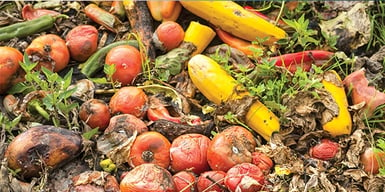
How Is Food Waste Recycled In The UK?
Every year in the UK a total of 9.52 million tonnes of food waste is generated. 70% comes from households, whilst manufacturers are responsible for another 16%, and hospitality and retail make up the other 12% and 2%, respectively. Where does it go?
There are four main destinations for food waste in the UK (2018 figures):
- Landfill (64%)
- Anaerobic digestion (33%)
- Commercial composting (2%)
- Waste-to-energy plants (incineration) (1%)
Let’s look at these:
- Landfill we all know about. The government has a target to reduce the amount of food waste going to landfill to zero by 2030. Food waste in landfill generates methane which is 80 times more effective at warming the atmosphere than carbon dioxide (CO₂). There are currently over 500 landfill sites in the UK. If you don’t want your food waste going to landfill tell your waste contractor. With a few exceptions, most food waste doesn’t have to end up in landfill.
- Anaerobic digestion (AD) is the preferred food waste recycling alternative of the government to landfill. It is a natural process in which plant and animal materials are converted into useful products by micro-organisms in the absence of air. Anaerobic means ‘without oxygen’. The process releases biogas, (mainly a mixture of around 60% methane and 40% carbon dioxide) which can be used directly to provide heat, power or transport fuel. Biogas can also be purified by removal of the carbon dioxide to produce biomethane, which can be fed directly into the public natural gas grid in the same way as natural gas or used as a vehicle fuel. The types of materials suitable for AD include food waste, slurry and manure, crops and crop residues. There are currently over 650 plants in the UK and this number is growing. Most food waste collected in the UK in wheelie bins by a waste contractor ends up here.
- Commercial composting (aerobic digestion) is generally used for green and garden waste. Aerobic means the use of oxygen. The waste is turned over regularly to allow air and bacteria to naturally break down the organic waste into regulated compost which is sold back to the public. There are around 270 plants in the UK. Between 5% and 10% of food waste collected in wheelie bins goes to a commercial composting plant.
- Waste-to-energy plants mainly burn general waste, biomass (wood and wood pellets), animal and crop waste to generate electricity which is fed into the grid. These plants are specially designed to burn at higher temperatures than traditional incinerator plants. These have sprung up rapidly in the last ten years and there are currently 54 plants in the UK. Currently, less than 3% of food waste collected in wheelie bins ends up here.
As a food waste producer, you have the choice of sending your food waste to one of these destinations via your waste contractor, generally in wheelie bins. You can reduce the cost of disposal significantly by using alternative technologies, but watch out, some of them will not be allowed from 2023.
- Macerator units which chop up food waste and flush it into the drains and liquidizing digesters (also sometimes wrongly termed aerobic digesters) which use enzymes and hot water to turn food waste into a slurry are banned in Scotland, Northern Ireland and Wales and will also be banned in England from 2023 with the passing of the Environment Act 2021. These technologies are widespread in hospitals and hotels in 2022 but will need to be removed and alternative technology used.
- Composting machine (aerobic digester). The process lasts from two to six weeks. You add woodchip each time you load food waste, which slowly decomposes leaving you with a compost which you can put on your grounds (not in Scotland though as the rules are different there). This will eliminate your cost of disposal.
- Food waste dried in the Eco-Smart Food Waste Dryer will be reduced by 80-90%. By drying the food waste before handing it to a food waste contractor you will reduce its volume and weight by 80% or more which will cut the number of collections by the same amount saving you money and reducing your carbon footprint.
If you want to reduce the cost of your food waste disposal or you would like further information on the Eco-Smart Food Waste Dryer click this link.

